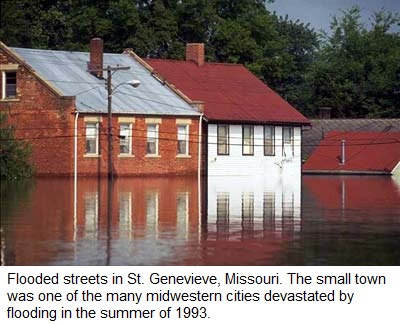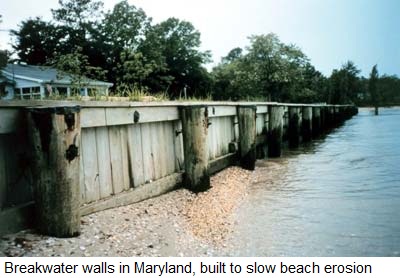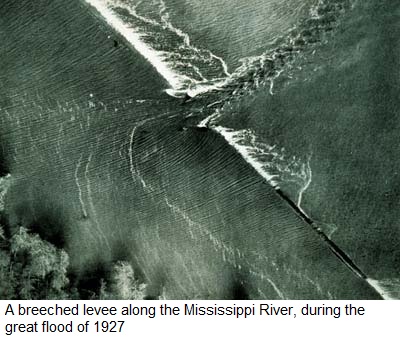|
|
|
|
 In
the last section, we saw that the degree of flooding is determined by
the amount of water that accumulates in an area, as well as the nature
of the land surface. As civilization has expanded, human beings have
altered the landscape in a number of ways. In the Western World, one of
the most significant changes has been covering the ground in asphalt and
concrete. Obviously, these surfaces are not the best sponges around:
Almost all rain that accumulates becomes runoff. In an industrialized
area without a good drainage system, it may not take much rain to cause
significant flooding. In
the last section, we saw that the degree of flooding is determined by
the amount of water that accumulates in an area, as well as the nature
of the land surface. As civilization has expanded, human beings have
altered the landscape in a number of ways. In the Western World, one of
the most significant changes has been covering the ground in asphalt and
concrete. Obviously, these surfaces are not the best sponges around:
Almost all rain that accumulates becomes runoff. In an industrialized
area without a good drainage system, it may not take much rain to cause
significant flooding.
Some cities, such as Los Angeles, have constructed concrete flood-relief
channels to prevent this problem. When it rains a lot, the water flows
into these channels, which meander out of the city where the water can
be better absorbed. These sorts of systems may cause flooding farther
down the line, however. When you cover an area in concrete and asphalt,
you are essentially cutting off part of the Earth's natural sponge, so
the rest of the sponge has a lot more water to deal with.
A similar problem can arise with levees, large walls built along rivers
to keep them from overflowing. These structures extend the natural banks
of the river so that much more water can flow through it. But while they
may be effective at keeping water out of one area, they usually make
problems worse for an area down the line, where there are no levees.
That area gets all the flood waters that would have spread out farther
up river. Another danger of levees is that, like dams, they can break.
When this happens, a large amount of water flows out onto the land in a
short period of time. This can cause some of the most dangerous flood
conditions.
 People
haven't had much success with controlling flooding along coastlines.
Excessive water in these areas is particularly destructive to man-made
structures because of the erosion it causes. One method of controlling
this erosion is to build fences and walls where the water meets the
land. This keeps the power of the waves at bay, so they don't wear down
the beach. But the structures also interfere with the process of beach
formation. When you block the water from moving against the coast, the
ocean can't distribute sand and you don't get beautiful beaches. People
haven't had much success with controlling flooding along coastlines.
Excessive water in these areas is particularly destructive to man-made
structures because of the erosion it causes. One method of controlling
this erosion is to build fences and walls where the water meets the
land. This keeps the power of the waves at bay, so they don't wear down
the beach. But the structures also interfere with the process of beach
formation. When you block the water from moving against the coast, the
ocean can't distribute sand and you don't get beautiful beaches.
Another problem with fences and walls is that there is only so much they
can do. Fundamentally, beaches are changing environments, molded by the
overpowering force of the ocean. They are, by their very nature,
supposed to be eroded and moved by the dynamic action of waves. Flooding
is a regular part of this process, and most likely will continue to be
no matter what we do.
 The
same can be said for many inland areas. While a river may appear to us
to be a stable, unmovable feature of the landscape, it is really a
vibrant, dynamic entity. This is particularly true of big rivers, such
as the Mississippi in the United States and the Yangtze and Huang He in
China. Over time, these waterways expand, shift their path dramatically
and may even change the direction of flow. For this reason, the land
around the banks of a river is highly susceptible to flooding. The
same can be said for many inland areas. While a river may appear to us
to be a stable, unmovable feature of the landscape, it is really a
vibrant, dynamic entity. This is particularly true of big rivers, such
as the Mississippi in the United States and the Yangtze and Huang He in
China. Over time, these waterways expand, shift their path dramatically
and may even change the direction of flow. For this reason, the land
around the banks of a river is highly susceptible to flooding.
Unfortunately, rivers are also natural draws for civilization. Among
other things, they provide a constant supply of water, rich soils and an
easy means for transportation. When the water level is low, people build
all along its banks and enjoy all its benefits. At some point, it comes
time for the water to shift, and the people who have built along the
flood plains quickly discover that they are living on unsound ground. If
there is extensive construction in these areas, the flood damage can be
devastating.

Source: http://science.howstuffworks.com |
|


 In
the last section, we saw that the degree of flooding is determined by
the amount of water that accumulates in an area, as well as the nature
of the land surface. As civilization has expanded, human beings have
altered the landscape in a number of ways. In the Western World, one of
the most significant changes has been covering the ground in asphalt and
concrete. Obviously, these surfaces are not the best sponges around:
Almost all rain that accumulates becomes runoff. In an industrialized
area without a good drainage system, it may not take much rain to cause
significant flooding.
In
the last section, we saw that the degree of flooding is determined by
the amount of water that accumulates in an area, as well as the nature
of the land surface. As civilization has expanded, human beings have
altered the landscape in a number of ways. In the Western World, one of
the most significant changes has been covering the ground in asphalt and
concrete. Obviously, these surfaces are not the best sponges around:
Almost all rain that accumulates becomes runoff. In an industrialized
area without a good drainage system, it may not take much rain to cause
significant flooding. People
haven't had much success with controlling flooding along coastlines.
Excessive water in these areas is particularly destructive to man-made
structures because of the erosion it causes. One method of controlling
this erosion is to build fences and walls where the water meets the
land. This keeps the power of the waves at bay, so they don't wear down
the beach. But the structures also interfere with the process of beach
formation. When you block the water from moving against the coast, the
ocean can't distribute sand and you don't get beautiful beaches.
People
haven't had much success with controlling flooding along coastlines.
Excessive water in these areas is particularly destructive to man-made
structures because of the erosion it causes. One method of controlling
this erosion is to build fences and walls where the water meets the
land. This keeps the power of the waves at bay, so they don't wear down
the beach. But the structures also interfere with the process of beach
formation. When you block the water from moving against the coast, the
ocean can't distribute sand and you don't get beautiful beaches. The
same can be said for many inland areas. While a river may appear to us
to be a stable, unmovable feature of the landscape, it is really a
vibrant, dynamic entity. This is particularly true of big rivers, such
as the Mississippi in the United States and the Yangtze and Huang He in
China. Over time, these waterways expand, shift their path dramatically
and may even change the direction of flow. For this reason, the land
around the banks of a river is highly susceptible to flooding.
The
same can be said for many inland areas. While a river may appear to us
to be a stable, unmovable feature of the landscape, it is really a
vibrant, dynamic entity. This is particularly true of big rivers, such
as the Mississippi in the United States and the Yangtze and Huang He in
China. Over time, these waterways expand, shift their path dramatically
and may even change the direction of flow. For this reason, the land
around the banks of a river is highly susceptible to flooding.